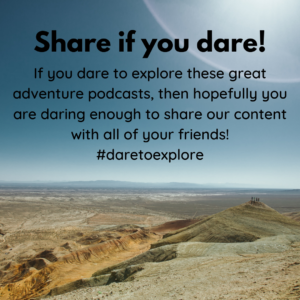Chapter 4: Podcasts
By the end of this chapter, you should be able to:
- Design new content for current courses. (LO2)
- Investigate new forms of media to engage students. (LO3)
Podcasts are typically just audio, but sometimes include video components, that cover a wide range of topics. If you can think of the topic, chances are there is a podcast out there somewhere that covers that topic. Podcasts are a great form of media, because they are easy to make with all of the free platforms available, and technically no special equipment is required. Podcasts are also very versatile in their times. Some will be eleven minutes, some an hour. There’s so much range!
In this process, there will be similar steps followed as the infographic process. Please note that there is no wrong or right way to build a podcast as long as you have recorded content and it is shareable. It may take time to find the right platform, topic, or routine, that works for you. Don’t give up! Also, don’t be afraid to assign podcast assignments to your students!
Step 1: Content
There are two significant camps in the podcasting arena. Those that prepare scripts to follow and those that don’t. Some would argue that scripted podcasts may be too formulaic or robotic, when compared to a podcast that is improvised. Decide what you like the best, knowing that your preference may adapt over time. Regardless of your camp, it is helpful to at least prepare some talking points and maybe some relevant research when developing a podcast episode. Potentially the worst thing is dead air. Dead air is when there is no sound, no music, nothing is happening. Avoid this by practicing and preparing as much content as you see fit. It may also be helpful to record with a friend or interview someone. This can take some of the pressure off of you and allow a more genuine interaction with the hypothetical listener.
Here is an example of a podcast that is scripted and edited later, provided by TrineOnline.
Step 2: Platform and Design
When you are ready to record, record using a platform that you are comfortable using. Most computers and mobile devices have audio recorders that work fine. But you can also try out platforms like Anchor by Spotify. Here you can create, distribute, even monetize your podcast all for free! As you begin, don’t forget to design a podcast profile image (Canva or Piktochart would be great help again) that is eye-catching and promotes your podcast the way you want it to be promoted.
Technically, you do not need special equipment to create a podcast of your own. However, it can be helpful to have a microphone that works well and a platform that offers editing. Editing can include trimming the parts that are bad or adding music to provide ambience. Below is an introduction video for Anchor. You can learn more via their YouTube Channel.
Step 3: Accessibility
In an attempt to not be redundant, this will be brief. If possible include captioning or transcripts for your podcast episodes. This will make your podcast accessible for all listeners, not just some listeners. Moreover, there are those who do not learn well by listening, so offering a written format allows them to enjoy the content without feeling excluded. Transcripts are also a good place to share your references. An excellent resource is the Faculty Focus Live Podcast, hosted by Tierney King. This podcast offers many platforms to listen to the episode, a brief summary of the podcast, recommended additional resources, and transcripts for every episode. They have many excellent learning opportunities for faculty, so I highly recommend looking at their website.
Here is one of the episodes from Faculty Focus Live and the link to their transcripts.
Step 4: Editing
Remember to listen to your podcast before sharing it. And then listen to it again. And then maybe one more time. Just like with other forms of editing, it is important to listen and review the content until it is exactly right. Taking the extra time to do this can really make a difference.
Step 5: Sharing
Depending on the mission of your podcasts, it might be helpful to focus your sharing. Maybe this includes social media, maybe it doesn’t. However you want to share it is up to you, but please do! You’ve worked hard and it’s time to celebrate! Share, share, share! Below is an example of what sharing your podcast could look like, include a graphic with a link to your podcast to attract more attention. It can be beneficial to use website that shorten links like Bitly or Cuttly. Long links are not accessible or attractive.

References:
Anchor. (2017, June 29). Anchor: the easiest way to make a podcast, all from your phone [Video]. YouTube. https://www.youtube.com/watch?v=M4oRmrXMKa8
Eberts, K. & Buell, K. (Host) (2021). Online learning trends in 2021. (No. 32) [Audio podcast episode]. The Onliners. TrineOnline. https://theonliners.transistor.fm/32
King, T., Ziska, K., Wehling, S. (2021). What fun! How to implement gamification strategies and play-based activities into your course (No. 23) [Audio podcast episode]. Faculty Focus Live. https://www.facultyfocus.com/faculty-focus-live-podcast/

